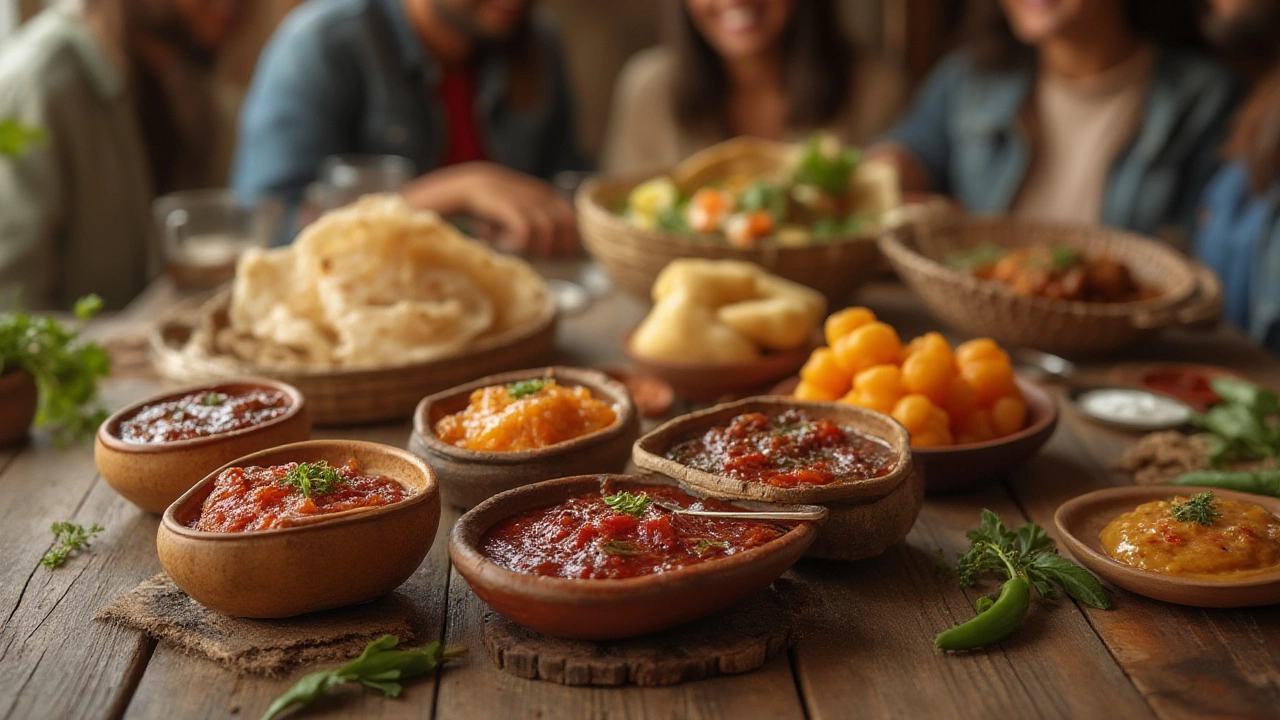Chilli jam shows up on shelves and recipes, drawing loads of attention. But hang on—a familiar jar of chutney sits right beside it at many Indian homes and global pantries. Lots of people scoop up both, sometimes wondering if they’re just giving the same thing a fancy name. Turns out, they’re not twins at all. At our house (between me and Anaya, who eats toast for fun), the spread debate gets surprisingly personal. Is that tangy kick on her paratha really jam or chutney? You can’t swap them in every dish without noticing. Spice lovers, home cooks, and even food geeks stumble here, mistaking shine for heat, pulp for paste, and tradition for trend. This is where mixing up terms actually mixes up flavors. So what separates chilli jam from chutney, and why does it even matter at your table? Grab that spoon—let’s pick this apart.
How Chilli Jam Is Made: Sweet Heat with a Modern Twist
First up, let’s talk ingredients. Chilli jam is usually built on three things: chillies (fresh red, not dried), sugar, and a splash of vinegar (white or apple cider are popular). Sometimes, you’ll spot a hint of garlic, ginger, or lemongrass—those are modern add-ins, but not the blueprint. The texture smacks of something you’d spread on bread: soft, glossy, easily scoopable but never chunky. It’s meant to look and act like classic jam—think apricot or strawberry—but it sizzles with heat and a burst of sweet. Unlike old-school fruit jams, the chilli takes the spotlight. You’ll see lots of recipes in the UK and Australia label it “chilli jam,” where it became a thing with Jamie Oliver fans about a decade ago.
Making chilli jam is a quick kitchen science lesson. The sugar dissolves into vinegar and boils up with chillies until everything thickens. If you’ve ever tasted a good jar, you’ll notice a clean, sticky feel—no big lumps, no stray seeds floating around (unless the maker’s lazy). Pectin, the same gel-maker from fruit jams, sometimes comes in handy for setting, but many recipes do just fine with a long simmer. In actual numbers, conventional chilli jam carries about 50-60% sugar, a classic preserve trick that also extends shelf life. Homemade versions? Expect a result that’s shelf-stable for up to a year, unopened, thanks to the sugar-vinegar balance.
The wild thing about chilli jam is how versatile it gets. It lands on burgers, in stir fries, drizzled over cheese boards, or whisked into dressings. Spoon it on grilled chicken: there’s the shine and bite. Stir it into yogurt: now you’ve built a dipping sauce that’s equal parts hot, sweet, and tart. Restaurants even sneak it into cocktails or use it for fancy plating drips. The takeaway? Chilli jam’s real superpower is how it bridges the street-food world with gourmet, making it the condiment with a serious personality complex.
What Goes Into Chutney: Complexity, Chunk, and Cultural Legacy
Chutney is the seasoned veteran in the condiment league, especially across the Indian subcontinent. There’s hardly a region—from Tamil Nadu to Gujarat—that doesn’t have its signature chutney. The ingredient list gets bigger here: not just chillies, but also onions, garlic, ginger, tomatoes, mango, coconut, mint, tamarind, or practically any seasonal fruit or veg. Instead of loads of sugar, chutneys use a balance—sugar, salt, acid, and spices—to build that famous flavor rollercoaster.
Let’s get real about texture. Chutney is usually chunky, spooned out in dollops or messy piles next to food. While you can blend some for a smoother dip, the signature is still the presence of pieces—bits of mango, shreds of coconut, visible mustard seeds, or even whole curry leaves floating in the mix. The cooking method is more relaxed, too. Some chutneys are quick—stone-ground with raw ingredients and eaten fresh, while others simmer for hours like Indian pickle (achar). The slow-cooked versions develop deep, caramelized flavors you won’t find in a jar of chilli jam.
Indian chutneys are not afraid of spice. You’ll meet jaggery (unrefined sugar) in south Indian recipes, fenugreek seeds in Gujarati mixes, or crushed peanuts in Maharashtrian ones. Even outside India, British-style chutneys became a Victorian obsession—chunky, vinegared, and sweetened for long ocean journeys. The numbers on taste are telling: chutneys range wildly, from tangy-cool coconut chutney (almost zero sugar) to rich mango chutney (about 30–40% sugar) packed for export. Our fridge boasts at least three: a mint-coriander green one for dosas, a brown tamarind one for samosas, and something deadly spicy from last Diwali that’s best unnamed.

The Big Differences: Taste, Texture, and Tradition Shown Side by Side
When you line up chilli jam and chutney, the differences stop being subtle. For starters, taste. Chilli jam is all about sweet-heat with a bright acidic pop. Sometimes it’s almost dessert-y until the chillies punch through, whereas chutney takes you on a spin: spicy, tangy, a touch of salty, often with a background hum of cooked garlic, cumin, or mustard seed. Chilli jam usually tastes clean; chutney gets complex with every bite.
Texture is where things get personal. Chilli jam wants to be smooth, sticky, and pourable. It’s like marmalade with attitude—no chunks or big flavor surprises. Chutney, though, is all about texture. The good ones should make you chew, savor, and even pick out pieces you love. Anaya, for what it’s worth, uses the chunkiness as a snack challenge; it’s not allowed to be boring.
Tradition splits the two even further. Chilli jam, at heart, is a newcomer—experimenting with global flavors and leaning heavily on Western jam-making techniques. Chutney, meanwhile, is about preserving produce and tradition, making something useful out of mangoes before they rot or turning coriander into the hero of any meal. You could call chutney a flavor time machine: it tastes like the kitchens of every grandmother who decided to eyeball her ratios and stir until it ‘smelled right.’
| Feature | Chilli Jam | Chutney |
|---|---|---|
| Main Ingredients | Chillies, sugar, vinegar | Varied: fruits/vegs, spices, sugar, vinegar/acid |
| Texture | Smooth, glossy, spreadable | Chunky or blended, often coarse |
| Origin | Modern, global (mostly Western) | Ancient Indian subcontinent |
| Sweetness (%) | 50–60% | 0–40% |
| Shelf Life (Unopened) | Up to 1 year | Varies: weeks to months |
| Common Uses | Burgers, cheese, sauces, glazes, toast | Dips, sides, marinades, snack toppings |
If you’re still guessing at the store, two tips: look at the label for "jam" = high sugar and a clear, uniform look; "chutney" = variety of ingredients, visible chunks, typically a spiced scent. My own trick is the spoon test: tilt the jar. Jam slides and clings, chutney plops and settles.
How to Use Each: Best Serving Tips and When to Substitute
So here’s the big real-life question—can you swap one for the other? The answer depends on the dish and your tastebuds. Chilli jam is perfect when you want that candy-sweet, spicy zip to cut through fatty foods. It wakes up a grilled cheese, livens up your breakfast eggs, and is pretty much designed for party platters where you want everything to sparkle. One of my quickest fancy tricks? Stir a spoonful through sour cream for a chip dip that disappears fast.
Chutney plays best beside hearty, earthy foods—think fried snacks (pakoras, samosa, bhajis), steamed idlis, rice dishes, and all types of curries. It weaves between flavors instead of smacking you with one. Chutneys do a slow burn: you taste sweet, then tangy, maybe a hint of bitter, usually spiced up for depth. If your meal feels flat, try a spoonful of fresh green chutney; you’ll see it transform instantly.
Want to swap? You can sometimes use chilli jam as a stand-in for sweet, hot chutneys—maybe in a sandwich or alongside roast meats. But try putting chilli jam next to a dosa—you’ll notice it melts too easily, runs everywhere, and can overpower delicate flavors. Subbing chutney for jam on toast sounds quirky, but some fruit chutneys (like apple or mango-cinnamon) actually work as a breakfast spread. I once sent Anaya to school with leftover tomato chutney on bread—her review: “weird, but yummy!”
If you’re tempted to try making one at home, here’s a quick breakdown of each process:
- Chilli Jam: chop chillies (deseed for milder jam), add sugar and vinegar, maybe garlic/ginger, cook until glossy, bottle hot.
- Chutney: chop your main fruit/veg, sauté spices in oil, add main ingredients, simmer with sugar and acid, taste-test often, jar once thickened.
Some fun flavor tips:
- Add a bit of star anise or cinnamon stick to your chilli jam for extra warmth.
- Roast onions or roast the chillies before making chutney to deepen flavor.
- Swirl chilli jam into hummus for a spicy twist.
- Balance too-tangy chutney with a sprinkle of brown sugar or raisins.
- Mix chutneys to create your own signature dip (I call it fridge magic).
And if you’re headed for the store, know this: jams and chutneys share shelf space but don’t always share the same purpose. Jam is about the punch; chutney is about the journey. Neither one replaces the other in every recipe, but having both in your fridge (or tucked near the dinner table) makes you ready for whatever your tastebuds crave next.
